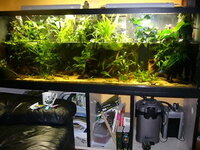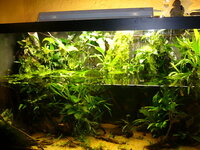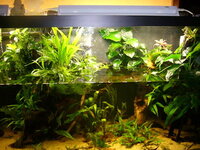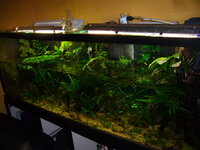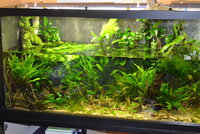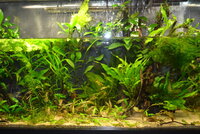here is an update of my planted tank, it is now planted over one year from when it started.
I have to say that i have learned loads from having a go at planting out a tank like this, there was no real plan originally, it just kind of took shape itself.it has not been fed anything for months but has had its regular (almost) daily water changes, the fish stock is much the same, though now there are some young baenchi swimming about and the morphos have almost doubled in numbers with young darting in and out of the plants every now and then, my lone male checkerboard died, so his harem are now only appreciating what a good thing us male really are, now they spend their days chasing apisto or morpho fry and talking about handbags and frocks.
next time i would not add any cardinals, they eat 99% of all fry and eggs in the tank
next fish to be added to this tank will be splash tetras.
on the plant front
it has been really interesting to see the difference in growth between above and below the water of Anubais species and cultivars.
seeing the changes in the moss growth habit and seeing it go into sexual reproductive stage sending up sporophytes, it will be interesting to see if new mosses start to appear here or there in the tank.
likewise the difference in Riccia growth above water.
if i set up a tank like this again i would use sturdier branches and build the framework up from day one before starting to add plants as one of the problems i encountered recently was some of the thinner pieces of wood cracking or bending with the weight of the plant mass as they matured.
The only new plant i added as a trial was an earth star (Cryptanthus sp.) that was sitting neglected on a dark window sill. It seems to have taken a liking to its new location, with the few offsets i broke off and placed on the wood taking hold and throwing out roots, makes me think about looking at some airplant species for the next tank for a bit of variance in plant shape colour and effect.
